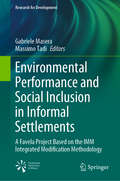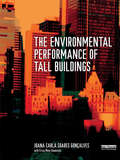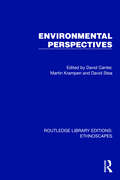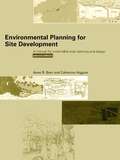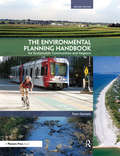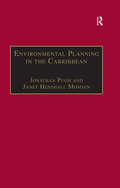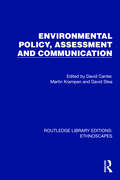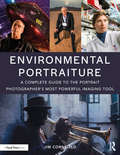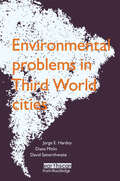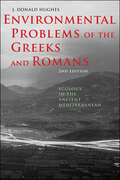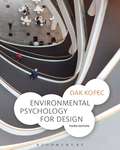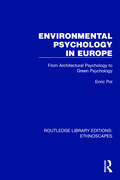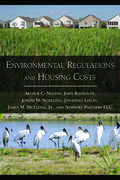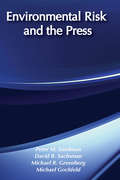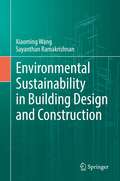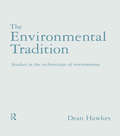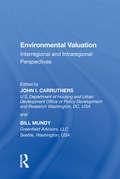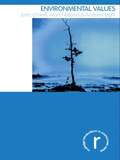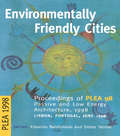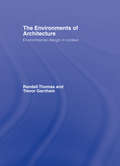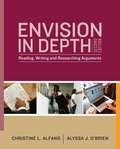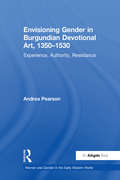- Table View
- List View
Environmental Performance and Social Inclusion in Informal Settlements: A Favela Project Based on the IMM Integrated Modification Methodology (Research for Development)
by Gabriele Masera Massimo TadiThis book discusses the potential of a systemic and multidisciplinary design approach to improve urban quality, health, livability, and inclusiveness for people living in informal settlements. In most instances, attempts to address informal settlements lack an adequate assessment of their impact on the wider built environment and implementation of the UN’s Sustainable Development Goals. The Integrated Modification Methodology (IMM), introduced here, offers a systematic, multidisciplinary design tool encompassing several of the aspects that define the environmental performance of urban systems. The book also demonstrates the application of the methodology to an informal settlement, proving its potential to guide systemicurban transformations, also in urban areas lacking formal planning. The case study investigated is in the Rocinha favela in Rio de Janeiro, which ischaracterized by poor water quality, lack of drainage and sanitation systems, and very few green spaces. Based on a rigorous methodology, the process described here can also be applied in similar contexts around the world.
The Environmental Performance of Tall Buildings
by Joana Carla GoncalvesTall buildings represent one of the most energy-intensive architectural typologies, while at the same time offering the high density work and living conditions that many believe will an important constituent of future sustainable communities. How, then, can their environmental impact be lessened? This insightful book takes in: an overview of the tall building and its impacts (looking at cityscape, place, mobility, microclimate, energy and economics) design principles and the development of the sustainable tall building global perspectives (covering North and South America, Europe, the Middle East and Asia) detailed, qualitative case studies of buildings in design and operation the future for sustainable tall buildings. Not simply another showcase for future utopian designs and ideals, the information presented here is based on hard research from operating buildings. Highly illustrated and combining analysis with solid detail for practice, this is essential reading for architects, building engineers, design consultants, retrofitters and urban planners interested in or working with tall buildings, and researchers/students in these disciplines.
Environmental Perspectives (Routledge Library Editions: Ethnoscapes)
by David Canter Martin Krampen David SteaOriginally published in 1988, reissued now with a new series introduction, Environmental Perspectives was the first in a trilogy of books to open the series Ethnoscapes: Current Challenges in the Environmental Social Sciences. These three titles brought together specially commissioned contributions that cover much of the range of topics that the series as a whole would cover. Although the following volumes would not have the same format, the opening trilogy gave an overview of what was to come, while also providing a broad base for the future authors to build upon.The first of these volumes focuses, essentially, on theory. It brings together papers covering our growing understanding of the ways in which human actions are integrated within our knowledge of the places in which those actions occur. The contributors also explore the social historical antecedents that give meaning to our everyday surroundings, as well as the psychological underpinnings to aesthetic experience.
Environmental Planning for Site Development: A Manual for Sustainable Local Planning and Design
by Anne Beer Cathy HigginsEnvironmental planning forms the basis of all site development decisions and deals with the factors that must be considered before a site plan can be drawn up. Environmental Planning for Site Development emphasizes the man/nature interface and explains how nature limits and controls what can happen on every piece of land. The text is clearly set out and will help the reader understand exactly what information is needed for a site planning proposal. The book includes a live case study to demonstrate how GIS systems are now assisting in the design and decision process as communities increasingly participate in local decisions. (Local Agenda 21)
Environmental Planning Handbook
by Tom DanielsEnvironmental protection is a global issue. But most of the action is happening at the local level. How can communities keep their air clean, their water pure, and their people and property safe from climate and environmental hazards? Newly updated, The Environmental Planning Handbook gives local governments, nonprofits, and citizens the guidance they need to create an action plan they can implement now. It’s essential reading for a post-Katrina, post-Sandy world.
Environmental Planning in the Caribbean (Urban Planning and Environment)
by Janet MomsenIllustrated by case studies from both smaller nations - such as Carriacou, Barbados and St Lucia - and larger countries - including Cuba, Mexico and Jamaica - this volume brings together leading writers on environmental planning in the Caribbean to provide an interdisciplinary contemporary critical overview. They argue that context is central to the practice of environmental planning in this region. Rather than focusing on a deterministic colonial geography and history, the contributors propose that, whilst a wide range of foreign planning influences can be felt in different contexts, environmental planning emerges in specific settings, through the fluid interaction between local and global relations of power. A number of chapters explore the effects of external discourses upon the region, while others examine discourses on Western-style democracy and tourism. Other important themes covered include participatory planning, urban planning, physical development planning, pest management, sustainable development, water pollution, conservation and ecotourism.
Environmental Policy, Assessment and Communication (Routledge Library Editions: Ethnoscapes)
by David Canter Martin Krampen David SteaOriginally published in 1988, reissued now with a new series introduction, Environmental Policy, Assessment and Communication, was the second in a trilogy of books to open the series Ethnoscapes: Current Challenges in the Environmental Social Sciences. These three titles brought together specially commissioned contributions that cover much of the range of topics that the series as a whole would cover. Although the following volumes would not have the same format, the opening trilogy gave an overview of what was to come, while also providing a broad base for the future authors to build upon.This volume has a practical orientation. Its contributions deal directly with research on those environmental matters on which government agencies and other organisations formulate policies or develop design strategies. This therefore covers the assessment and evaluation of designs and design proposals as well as background research to policy issues.
Environmental Portraiture: A Complete Guide to the Portrait Photographer’s Most Powerful Imaging Tool
by Jim CornfieldThis unique book is a photographer’s guide to the powerful medium of the environmental portrait. It explores in lucid detail the many "moving parts" of this imaging style, including the techniques and creative processes that drive some of this genre’s finest contemporary practitioners. In Environmental Portraiture, author Jim Cornfield puts his readers behind the viewfinder to help them successfully master what he calls "the portrait photographer’s most high-powered tool." In a series of detailed tutorial chapters and study models, Cornfield unpacks every practical aspect of the environmental portrait scenario, including research, location scouting, lighting interior and exterior environments, props and wardrobe, lens selection, composition, color, and after-capture. Along with this wealth of comprehensive nuts-and-bolts information, the book probes the deep structure of environmental portraiture—the blend of a sitter’s backstory with the meaningful visual clues in their surroundings. He introduces such concepts as "portraitcraft," "cognitive weight," and "the ideas and emotions quotient," among the many dimensions of an environmental portrait that create eye-opening revelations about the person in front of your lens. A separate section of the book is devoted to a prestigious roster of contemporary environmental portraitists, specifically recruited for this book to explore in-depth selected samples from their diverse portfolios. They bring with them a score of insights, tips and fascinating anecdotes that demonstrate their individualized approaches to this versatile branch of the photographer’s craft. Written for professionals, amateurs and serious students of photography, this book is both a guide and inspiration to creating powerful, communicative environmental portraiture.
Environmental Problems in Third World Cities
by Jorge E. Hardoy Diana Mitlin David SatterthwaiteDescribes and analyses the environmental problems of Third World cities, showing how they affect human health and the local ecology. The authors show how readily available practical solutions are, if the political means can be found.
Environmental Problems of the Greeks and Romans: Ecology in the Ancient Mediterranean (Ancient Society and History)
by J. Donald HughesHow did ancient societies change the environment and how do their actions continue to affect us today?In this dramatically revised and expanded second edition of the work entitled Pan’s Travail, J. Donald Hughes examines the environmental history of the classical period and argues that the decline of ancient civilizations resulted in part from their exploitation of the natural world. Focusing on Greece and Rome, as well as areas subject to their influences, Hughes offers a detailed look at the impact of humans and their technologies on the ecology of the Mediterranean basin. Evidence of deforestation in ancient Greece, the remains of Roman aqueducts and mines, and paintings on centuries-old pottery that depict agricultural activities document ancient actions that resulted in detrimental consequences to the environment. Hughes compares the ancient world's environmental problems to other persistent social problems and discusses attitudes toward nature expressed in Greek and Latin literature. In addition to extensive revisions based on the latest research, this new edition includes photographs from Hughes's worldwide excursions, a new chapter on warfare and the environment, and an updated bibliography.
Environmental Psychology for Design
by Dak KopecHow does a room affect an occupant's behavior and well-being? How does a building influence its residents' health? Environmental Psychology for Design, 3rd Edition, explores these questions with an in-depth look at psychosocial responses to the built environment. Awarded the 2006 ASID Joel Polsky Prize, the first edition served as an introduction to the discipline of environmental psychology and inspired readers to embrace its key concepts and incorporate them into their practice. This 3rd edition continues to analyze the interaction between environments and human behavior and well-being, while exploring how individual differences related to age, gender, and cultural background impact that interaction.
Environmental Psychology in Europe: From Architectural Psychology to Green Psychology (Routledge Library Editions: Ethnoscapes)
by Enric PolOriginally published in 1993, as part of the Ethnoscapes: Current Challenges in the Environmental Social Sciences series, reissued now with a new series introduction and new preface, Environmental Psychology in Europe: From Architectural Psychology to Green Psychology sets out to explain the nature of environmental psychology, how it was born, how it developed, what were its dominant subjects, its principal actors and its present state in Europe at the time. The volume covers each European country, looking at the origin and development of the subject in the principal European cultural areas.
Environmental Regulations and Housing Costs
by Jonathan Logan Arthur C. Nelson Llc Newport Partners Joseph M. Schilling James M. Mcelfish John RandolphMany communities across the nation still lack affordable housing. And many officials continue to claim that "affordable housing" is an oxymoron. Building inexpensively is impossible, they say, because there are too many regulations. Required environmental impact statements and habitat protection laws, they contend, drive up the costs of construction. But is this actually true? In a comprehensive study of the question, the authors of this eye-opening book separate fact from myth. With admirable clarity, they describe the policy debate from its beginning, review the economic theory, trace the evolution of development regulation, and summarize the major research on the topic. In addition, they offer their own research, accompanied by a case study of two strikingly different Washington, D.C., suburbs. They also include results of focus groups conducted in Dallas, Denver, and Tucson. The authors find that environmental regulatory costs--as a share of total costs and processes--are about the same now as they were thirty years ago, even though there are far more regulations today. They find, too, that environmental regulations may actually create benefits that could improve the value of housing. Although they conclude that regulations do not appear to drive up housing costs more now than in the past, they do offer recommendations of ways in which the processes associated with regulations--including review procedures--could be improved and could result in cost savings. Intended primarily for professionals who are involved in, or impacted by, regulations--from public officials, planners, and engineers to housing developers and community activists--this book will provide useful insights and data to anyone who wants to know if (and how) American housing can actually be made "affordable."
Environmental Restoration: Proceedings of F-EIR Conference 2021 (Lecture Notes in Civil Engineering #232)
by Deepankar Kumar Ashish Jorge De BritoThis book gathers peer-reviewed contributions presented at the F-EIR Conference 2021, Environment Concerns and its Remediation, held in Chandigarh, India, on October 18-22, 2021. The respective papers focus on environmental monitoring and remediation, and cover topics such as efficiency in the use of energy, water, resources and human capital, waste minimization & management, durability and sustainability of building materials, green technologies, environmental sustainability and resilience, renewable energy, prevention and management of water pollution, life cycle assessment, and climate change. Accordingly, the book offers a valuable, up-to-date tool and essential overview of the subject for scientists and practitioners alike, and will inspire further investigations and research.
Environmental Risk and the Press
by Peter M. SandmanToxic spills, acid rain, poor air quality-scarcely a day goes by without a report in the press on an environmental risk issue. Nowhere is this more prevalent than in New Jersey, a leading state in the production of chemicals, and the state with the largest number of Superfund cleanup sites. How accurate and how extensive is environmental risk reporting in the New Jersey press, and what can be done to improve the quality of its coverage of environmental risk? And what can we learn from the New Jersey experience?Environmental Risk and the Press sets out to answer these questions. The authors explore the strengths and weaknesses of environmental risk reporting in New Jersey by evaluating the state's best environmental risk stories. They find that even the best stories have a number of problems, and they develop a number of concrete recommendations for reporters and editors on how to improve their coverage in this area.The authors also investigate the feasibility of various methods for getting environmental risk information to reporters and into their newspapers. They recommend three ways to improve the quality of environmental risk information available to journalists. The first is nationwide distribution of environmental press kits that include a directory of news sources, a glossary of technical terms, and briefings by experts on strategies for covering particular types of environmental risk situations. The second is continuing education programs on environmental risk for reporters and editors. The third is creating collections of relevant reference books in the offices of newspapers and broadcast stations. The authors report on initial actions taken to implement these recommendations, and plans for others. They conclude that the broader availability of environmental risk information to the media will result in better reporting of environmental problems. This book is a first step toward enhancing journalists' appreciation of the importance of risk as an issue in environmental news coverage, and providing them with the tools to help them act upon that heightened awareness.
Environmental Sustainability in Building Design and Construction
by Xiaoming Wang Sayanthan RamakrishnanThis monograph offers analyses of construction activities using various key concepts and assessments of sustainable development, and provides students and researchers with methodologies and design aspects for the sustainable development of the built environment. Additionally, the book demonstrates various national and international policies for assisting architects, engineers and policy makers in understanding the relevant decision-making approaches to sustainable development in construction. The book begins by reviewing the background of sustainability and sustainable development. The focus then turns to the effects of climate change on the built environment, including impacts of energy and carbon emissions, as well as constraints on water and waste management. The remaining chapters discuss the necessary approaches to achieve sustainable waste management, energy efficient building design, and resilience and adaptation in the built environment In eight chapters, the book encourages readers to think independently, logically and objectively about the complex issues presented by the applications of sustainable development in construction, including resource efficiency, environmental impacts, human health, building economics and social development.
The Environmental Tradition: Studies in the architecture of environment
by Dean Hawkes Dr Dean HawkesThis text brings together a unique collection of writing by a leading researcher and critic which outlines the evolution of the environmental dimension of architectural theory and practice in the past twenty-five years. It deals with the transformation of the environmental design field which was brought about by the growth of energy awareness in the 1970s and 1980s, and places environmental issues in the broader theoretical and historical context in architecture.
Environmental Valuation: Interregional and Intraregional Perspectives (Urban Planning And Environment Ser.)
by Bill MundyEnvironmental quality is one of the most important issues faced by contemporary urban and regional policy. Amenities such as access to the natural environment, attractive neighbourhood characteristics and high quality public goods and services, play a direct role in determining where people choose to live and how much they are willing to do so. Likewise, negative environmental conditions, such as contamination, influence the real estate markets and the 'value' of a region. Increasingly, regions become winners or losers based on the quality of life they offer their inhabitants. Bringing together a team of leading scholars, this book addresses the issues of environmental valuation, answering questions such as: What kinds of features matter? How large of an affect do they have? How do they affect the spatial distribution of the population? And how should the value that people place on their environment affect urban and regional policy?
Environmental Values
by Andrew Light John O'Neill Alan HollandWe live in a world confronted by mounting environmental problems; increasing global deforestation and desertification, loss of species diversity, pollution and global warming. In everyday life people mourn the loss of valued landscapes and urban spaces. Underlying these problems are conflicting priorities and values. Yet dominant approaches to policy-making seem ill-equipped to capture the various ways in which the environment matters to us. Environmental Values introduces readers to these issues by presenting, and then challenging, two dominant approaches to environmental decision-making, one from environmental economics, the other from environmental philosophy. The authors present a sustained case for questioning the underlying ethical theories of both of these traditions. They defend a pluralistic alternative rooted in the rich everyday relations of humans to the environments they inhabit, providing a path for integrating human needs with environmental protection through an understanding of the narrative and history of particular places. The book examines the implications of this approach for policy issues such as biodiversity conservation and sustainability. Written in a clear and accessible style for an interdisciplinary audience, this volume will be ideal for student use in environmental courses in geography, economics, philosophy, politics and sociology.
Environmentally Friendly Cities: Proceedings of Plea 1998, Passive and Low Energy Architecture, 1998, Lisbon, Portugal, June 1998
by Eduardo MaldonadoThe 15th Passive and Low Energy Architecture (PLEA) conference considered the issues of sustainability and environmental friendliness at the city scale. Some 150 papers address the many and varied questions faced by architects and planners in reducing the impact on the environment of cities and their buildings.
The Environments of Architecture: Environmental Design in Context
by Randall Thomas Trevor GarnhamThis well-illustrated 'think piece' provides a much needed and topical philosophical introduction to the place of environmental design in architecture. The Environments of Architecture sets out a range of considerations necessary to produce appropriate internal environments in the context of a wider discussion on the effect of building decisions on the broader environment. The authors, from architecture and engineering, academia and practice, provide a rounded and well-balanced introduction to this important topic. Starting from a belief that the built environment can contribute more positively to the planet and the pleasure of places as well as answering the practical demands of comfort, they cover site planning, form, materials, construction and operation as well as looking at design on a city level. Presenting a thoughtful and stimulating approach to the built environment, this book forms an excellent guide for practitioners, students and academics concerned with our built environment.
Envision In Depth: Reading, Writing, and Researching Arguments
by Christine Alfano Alyssa O'BrienEnvision in Depth: Reading, Writing, and Researching Arguments 2/e, is a combined rhetoric and reader intended for composition courses focusing on argumentation and research-based writing. Taking contemporary culture as its central theme and context, Envision in Depth is concerned with the fundamentals of analyzing and writing powerful, effective arguments. Students using Envision in Depth will learn how to analyze and compose arguments, design and conduct research projects, and produce persuasive visual and oral presentations in response to over 100 contemporary arguments in a wide range of verbal and visual genres.
Envisioning Better Communities: Seeing More Options, Making Wiser Choices
by Randall ArendtThe author's work has shaped a generation of planners, designers, and landscape architects. In this book, the author brings his insights to a broader public, with a profusely illustrated demonstration of how local officials, planning commissioners, and everyday citizens can work to make their communities more attractive, more habitable, and more sustainable. Despite the widespread acceptance of good design and planning principles throughout the professions, too many of our towns and rural areas remain needlessly ugly and inefficient. In side by side comparisons of similar places and kinds of buildings, the author shows that we need not live amid sprawling, characterless visual blight. Simple design choices and effective municipal decisions can have tremendous impacts on the quality of our communities. Written in the author's well-known clear, accessible, nontechnical style, this book creates a sense of hope for those who face the everyday challenges of working with developers and landowners to create places that make economic, environmental, and aesthetic sense. The author shows us that with diligence, thoughtfulness, and care, we can make our communities better in countless ways.
Envisioning Embodiment in the Health Humanities: Interdisciplinary Approaches to Literature, Culture, and Media (Sustainable Development Goals Series)
by Jodi Cressman Lisa DeTora Jeannie Ludlow Nora Martin PetersonEnvisioning Embodiment in the Health Humanities: Literature, Culture, and Media examines discourses of embodiment across disability studies, gender studies, cultural studies, and visual studies to inform educational practice as well as cultural criticism related to the health and medical humanities. The book argues that imagery and other visual elements in literature, comics, lived experience and the arts demonstrate the hybridity of the embodied experience and identity and have something to offer to clinical practice. Connected to the UN Sustainable Development Goals 3 (Health), 4 (Gender equality), and 16 (Strong institutions), the topics addressed in the essays include mental health, grief, COVID-19, healthcare practices, cancer, and women’s health. The volume is designed to be accessible to advanced undergraduate students as well as graduate students and to be useful for medical practitioners and others who are interested in the health humanities, disability studies, gender studies, or cultural studies.
Envisioning Gender in Burgundian Devotional Art, 1350–1530: Experience, Authority, Resistance (Women and Gender in the Early Modern World)
by Andrea PearsonIlluminated here are the relationships between visual culture, faith, and gender in the courtly, monastic, and urban spheres of the early modern Burgundian Netherlands. By examining works by artists such as the Master of Mary of Burgundy, Jan van Eyck, Hans Memling, and Bernard van Orley, author Andrea Pearson identifies and explores pictorial constructions of masculinity and femininity in regard to the expectations, experiences, and practices of devotion. Specifically, she demonstrates that two of the most prominent visual genres of the period, books of hours and devotional portrait diptychs, were manipulated by patrons and spectators of both sexes to challenge and negotiate the boundaries and hierarchies of gender, and that marginalized individuals and groups appropriated the types to resist the authority of others and advance their own. Ultimately, the books and diptychs emerge as critical and often contentious sites for deliberating and transacting gender. By integrating books of hours and devotional portrait diptychs into current interdisciplinary theoretical discourse on gender, power and devotion, the author engages scholars in a range of disciplines: art history, history, religion and literature, as well as women's and men's studies.
